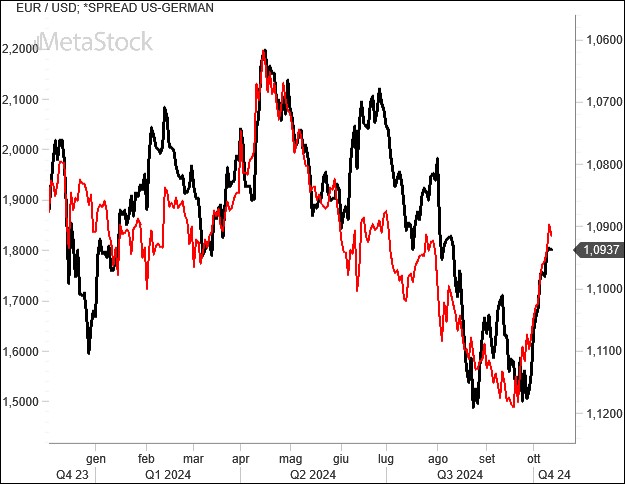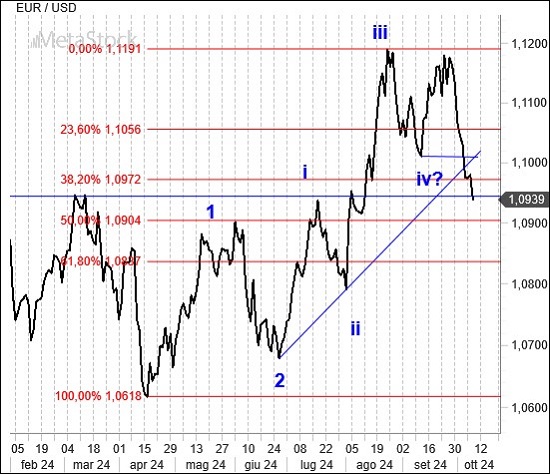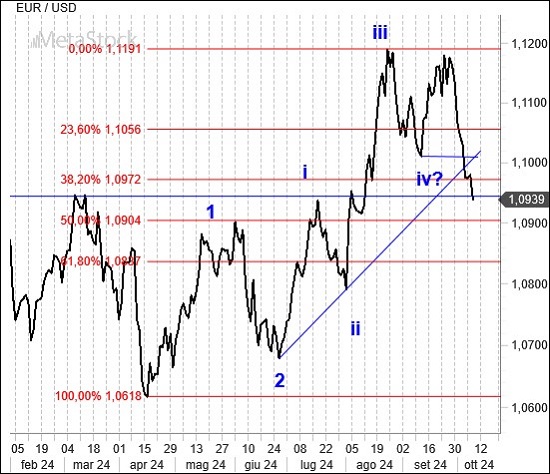- The U.S. economy is expected to grow by more than 3% in the third quarter, which diminishes the likelihood of aggressive rate cuts by the Fed. Consumer and producer prices have essentially stopped declining.
- The European Central Bank (ECB) is expected to announce a rate cut this week due to the slowing Eurozone economy and inflation quickly converging toward 2%.
- EUR/USD remains below 1.10, driven by the widening rate differential between 10-year U.S. and German bonds, making U.S. securities more attractive than European ones.
U.S. Growth Stays Strong, Inflation Eases Rate Cut Hopes as ECB Gears Up for Action
Minutes from the recent September Federal Reserve meeting indicate a resilient U.S. economy, ruling out recession in the near term. Growth forecasts remain strong. According to the Atlanta Fed’s GDP Now model, third-quarter growth is projected to exceed 3%, a figure consistent with forecasts from the New York Fed.
Market expectations for rate cuts have cooled, with analysts now pricing in a 25-basis-point cut at each of the November and December meetings. This moderation in expectations, along with the rise in 10-year U.S. Treasury yields back above 4%, is largely due to inflation. Both consumer and producer prices exceeded expectations.
In September, U.S. inflation rose 2.4% (compared to 2.5% in July and 2.3% expected by analysts), with core inflation at 3.3%. Similarly, producer prices, often a precursor to consumer price trends, showed strong results. The Producer Price Index (PPI) rose 1.8% year-on-year in September, but the core PPI figure, which excludes food and energy, surprised with a 2.8% increase, up from 2.6% in August.
In contrast, the conviction that borrowing costs must fall quickly is growing in Europe. The ECB is expected to deliver a more substantial and rapid rate cut to reinvigorate an economy that is sagging and in need of monetary stimulus now that inflation is swiftly approaching the 2% target. This week’s ECB meeting is expected to include a 25-basis-point cut, with a total of 150 basis points expected over the next 12 months.
Technical Analysis: Rate Differentials Drive Dollar Strength as EUR/USD Breaks Key Support Levels
Short-term interest rate differentials are currently influencing the valuation of the U.S. dollar. Some positive U.S. growth data has been enough to pull the dollar away from dangerous lows, offering a moderate rally. A more significant surge could occur if U.S. and Eurozone monetary policies begin to diverge sharply.
However, signals from Washington suggest a need for more moderate rate cuts than expected just a few weeks ago. The market has adjusted its expectations from 175-200 basis points in cuts over 12 months to 100-125.
The rate differential between the U.S. and Germany in 10-year bond yields highlights why the euro has weakened in recent days. A favorable spread for U.S. Treasuries provides sufficient returns to investors, encouraging them to hold dollars.

We revisit last week’s EUR/USD chart, incorporating Elliott Waves and Fibonacci retracement levels to help explain price movements. As the chart shows, breaking below 1.10 has had a detrimental effect on the euro. The currency, with this double top formation, is theoretically heading toward 1.08.
The euro’s last hope lies around the 1.0905 level, which corresponds to the top of Wave 1 and a 50% retracement of the entire recent rally. A break below this level would pave the way for a further decline.



Leave a Reply
You must be logged in to post a comment.